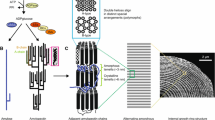Abstract
The proteinogenic amino acid proline has multiple functions in living cells. Depending on whether it is used as a building block in proteins, as a nutrient, or as an osmostress protectant, the cytoplasmic proline con-centration required for these tasks varies dramatically. The soil bacterium Bacillus subtilis solves this problem by precisely regulating and highly integrating catabolic, anabolic, and stress protective processes.
Similar content being viewed by others
Literatur
Moses S, Sinner T, Zaprasis A et al. (2012) Proline utilization by Bacillus subtilis: uptake and catabolism. J Bacteriol 194:745–758
Belitsky BR (2011) Indirect repression by Bacillus subtilis CodY via displacement of the activator of the proline utilization operon. J Mol Biol 413:321–336
Brill J, Hoffmann T, Putzer H et al. (2011) T-box-mediated control of the anabolic proline biosynthetic genes of Bacillus subtilis. Microbiology 157:977–987
Hoffmann T, Wensing A, Brosius M et al. (2013) Osmotic control of opuA expression in Bacillus subtilis and its modulation in response to intracellular glycine betaine and proline pools. J Bacteriol 195:510–522
Brill J, Hoffmann T, Bleisteiner M et al. (2011) Osmotically controlled synthesis of the compatible solute proline is critical for cellular defense of Bacillus subtilis against high osmolarity. J Bacteriol 193:5335–5346
Hoffmann T, von Blohn C, Stanek A et al. (2012) Synthesis, release, and recapture of compatible solute proline by osmotically stressed Bacillus subtilis cells. Appl Environ Microbiol 78:5753–5762
Author information
Authors and Affiliations
Corresponding author
Additional information
Tamara Hoffmann 1990–1995 Biologiestudium an den Universitäten Gießen und Marburg. 1995–1998 Promotion am Institut für Biochemie der Universität Freiburg. 1999 Postdoc am Max-Planck-Institut für terrestrische Mikrobiologie, Marburg. Seit 1999 wissenschaftliche Angestellte am Fachbereich Biologie (Molekulare Mikrobiologie) der Universität Marburg.
Erhard Bremer 1974–1980 Biologiestudium an der Universität Tübingen. 1980–1981 Promotion am Max-Planck-Institut für Biologie und der Universität Tübingen. 1982–1984 Postdoc am National Cancer Institute, Frederick, MD, USA. 1984–1992 Hochschulassistent/Dozent (C1/C2) an der Universität Konstanz. 1992–1995 Arbeitsgruppenleiter (C3) am Max-Planck-Institut für terrestrische Mikrobiologie, Marburg. Seit 1995 Professor (C4) für molekulare Mikrobiologie an der Universität Marburg.
Rights and permissions
About this article
Cite this article
Hoffmann, T., Bremer, E. Prolin — vielfältig wie ein Schweizer Taschenmesser. Biospektrum 19, 723–725 (2013). https://doi.org/10.1007/s12268-013-0381-2
Published:
Issue Date:
DOI: https://doi.org/10.1007/s12268-013-0381-2




